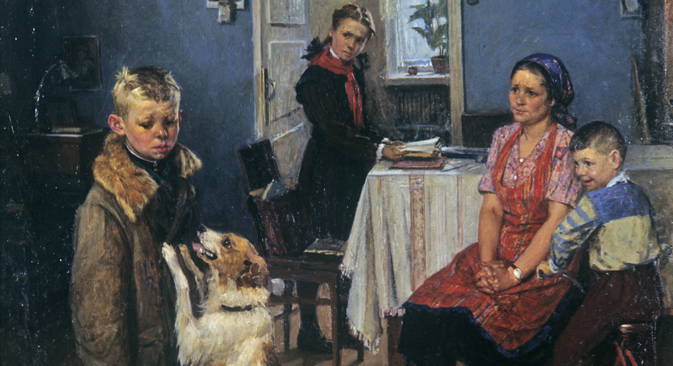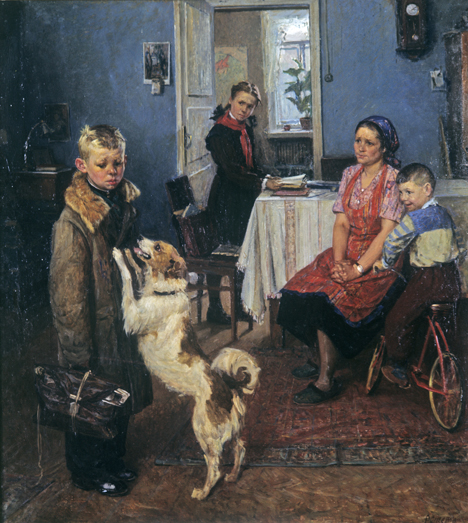

Reproduction of Fyodor Reshetnikov's Another Two, (Opyat Dvoika) 1948/1949, oil on canvas. The State Tretyakov Gallery. Source: Balabanov / RIA Novosti
There is a painting by Soviet artist Fyodor Reshetnikov called Another Two, dated 1952. It portrays a sad schoolboy who has once again brought a bad mark home from school. His sister, a star student, looks at him with a judgmental look on her face, while his mother looks concerned and his younger brother is laughing. Only the dog is happy to see him.
Officially, a ‘two’ is not the lowest mark in the Russian system, because there is also the ‘one’ (the ‘one’ is the equivalent of an ‘F’ in the American grading system). Why, then, does the downtrodden boy look as if he couldn’t have done any worse?
Back in the 17th century, teachers conventionally categorized students into three groups. The first category included successful students (“fair, reliable, kind, honest, good, commendable”), the second included average students (“mediocre, measured, well behaved”), and the third below-average students (“weak, contemptible, naughty, unreliable, lazy”). There were no classes in school; the category merely indicated a student’s position among other students.
This system was preserved in rural schools up until the latter half of the 19th century. Leo Tolstoy had a character named Filipok – a boy who dreamed of going to school but whose mother forbade him to study. One day, when he was alone in his grandmother’s care, he put on his father’s hat and ran away to just such a school.
Zeroes, stakes, and switches
The first attempt to replace the practice of defining students in a group with a grading system was made at the beginning of the 19th century. At that time, in addition to the five-point scale known today, an additional disciplinary assessment of ‘zero’ was also used. A student could receive a ‘zero’ for failing to do his or her homework on one occasion and be physically punished in front of the other students for not doing his or her homework on two occasions.
Birch switches were the favorite tools used by teachers to punish their students, who were usually whipped on the hands and shoulders. With the abolishment of corporal punishment in 1864, the ‘zero’ mark was also done away with, and the ‘one’ took on the role of “disciplinary mark.” For its resemblance to a bare stick, the ‘one’ came to be referred to as “the stake.”
The government tried to introduce a five-point system during the Soviet Union, but the innovation did not survive in its entirety. Until the end of the 1940s, students could receive “the stake” for pranks and disobedience. This mark was often used when the teacher wanted to draw attention to inappropriate behavior. However, by the middle of the century teachers had virtually ceased to use the ‘one’.
“I entered first grade in 1944. They gave us ‘ones’ for not doing our homework,” says 77-year-old Klavdiya Ivanovna. “We didn’t call them ‘the stake’ because that sounded even more insulting. I didn’t have any ‘stakes’, but I remember I sat next to a boy in first grade who copied my quiz. I got a ‘five’, but he got a ‘one’ for cheating. By the time I finished school, they weren’t giving ‘ones’ anymore,” she says.
Where did the ‘one’ go?
The fact that ‘ones’ are considered a disciplinary mark explains why they have almost never been used in universities. If a student misbehaves, he or she would probably just be expelled.
Education historians have also noticed a tendency to avoid assigning the lowest mark to students. They agree that Russian schools are inclined to use a four-point system in which the lowest mark is frequently either disciplinary or indicates a full lack of knowledge of the subject.
“Traditionally, we have assumed that knowledge can be excellent, good, satisfactory, or unsatisfactory,” says Yekaterina Vishnevetskaya, the head of an elementary school in Moscow. “In the 1990s, schools were given permission to choose how they wanted to evaluate their students. For example, in Moscow there are schools where people are graded on a letter scale. But there is a general rule that the transcript should contain one of our marks, from ‘two’ to ‘five’.” Vishnevetskayaadds that there is currently no document in Russia requiring teachers to assess the daily achievements of their students in any particular system.
In all likelihood, psychological motivations lie behind teachers’ reluctance to assign ‘ones’ to their students. “The ‘one’ is often referred to as ‘the stake.’ I think that’s the main reason why the mark went out of use,” explains Tatyana Kuchinskaya, a Russian language teacher at a Moscow high school.
“The problem is that the word ‘stake’ evokes negative associations in students’ minds, which is why it’s almost never used. After all, a stake is a stick, a sharpened pole, and the word is often used in phrases with a negative meaning. If something is protruding out sloppily, we say it’s ‘like a stake’. You can also say that about tasteless food that’s hard to swallow,” says Kuchinskaya.
“It’s not very nice to give a child a ‘stake’ when the phrase ‘drive a stake through him’ goes through your head. After all, that’s exactly how they executed criminals in old times,” she says.
Nonetheless, each individual school administration is entitled to choose how students are graded, and for that reason some schools still utilize the ‘one.’ In response to a question by RBTH, one Moscow student joked, “If somebody doesn’t get it [a ‘one’], it’s because they got lucky with their teacher!”
There is also a general trend not to assign ‘ones’ in the Unified State Exam. This centralized test is both a graduation examination and a university entrance exam. The first experimental test was conducted in 2001. Later, it was made mandatory for a larger and larger number of Russian regions with each year. The Unified State Exam always evaluates test takers on a 100-point system; however, careless students manage to avoid the dreaded ‘stake’ even in this test. According to statistics, the minimum score is 20.
All rights reserved by Rossiyskaya Gazeta.
Subscribe
to our newsletter!
Get the week's best stories straight to your inbox